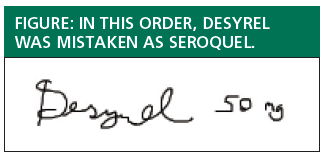Publication
Article
Pharmacy Times
Brand Name Confusion
Author(s):
Brand names that look or sound alike play a large role in medication errors.
Brand names (trademarks) are intended to be unique and memorable so that one drug product can be distinguished from another. However, brand names that look or sound alike play a large role in medication errors. Below are a few examples of brand name mix-ups reported to the ISMP National Medication Errors Reporting Program (www.ismp.org/merp).
Brintellix and Brilinta
A family medicine physician was attempting to electronically prescribe Brintellix (vortioxetine) 10 mg daily for a patient’s major depressive disorder. However, after typing the first few letters of the brand name into the computer system, he incorrectly selected Brilinta (ticagrelor), an antiplatelet agent that is used in patients with acute coronary syndrome. In this case, Brintellix being a 10-mg tablet (also available in 5-, 15-, and 20-mg tablets) and Brilinta being a 90-mg tablet did not prevent this selection error and the patient picked up the prescription from the pharmacy. Later, at home, she read the attached information regarding this new medication and realized that it did not sound like something she was supposed to take for depression. She further researched the medication online and contacted her physician to make sure this was the right medication. The physician realized the error, told his patient not to take Brilinta, sent the correct prescription for Brintellix to the pharmacy, and instructed the patient to take the Brilinta prescription back to the pharmacy. The patient never took any doses of Brilinta.
These rather new drug names share the same first 3 letters and other letters as well. Although this is the first report of an actual mix-up, an earlier report expressed concern about the look-alike nature of these drug names.

A prescription for Desyrel (trazodone) 50 mg was mistaken for Seroquel (quetiapine) 50 mg (Figure; courtesy of the ISMP). Both medications may be used for patients given a psychiatric diagnosis. The error was only noticed by the patient right before he paid for the prescription at the pharmacy because the cost of the Seroquel was much higher than what he was used to paying for the Desyrel. Although electronic prescribing is not perfect, it can help prevent mix-ups involving poor handwriting.
Farxiga and Fetzima
The FDA is aware of several reported mix-ups due to name confusion between Farxiga (dapagliflozin) and Fetzima (levomilnacipran). Farxiga was approved in January 2014 to lower blood glucose levels in adults with type 2 diabetes when used with diet and exercise. It is available in 5- and 10-mg tablets. Fetzima was approved in July 2013; it is a selective norepinephrine and serotonin reuptake inhibitor for major depressive disorder and is available in 20-, 40-, 80-, and 120-mg extended-release capsules.
Upon review of 5 medication error reports received by the FDA, it is believed that the errors can largely be attributed to the drugs being approved and marketed within 6 months of one another, as well as both drug names beginning with the letter F and ending with the letter A, being the same length, and having the same number of syllables. Prescribers and pharmacists also may choose the wrong item from computer screens. Furthermore, the container labels might appear similar since both display the proprietary name of the product in red font.
Endnote
Take steps to reduce the risk of mix-ups between these drugs, including software programs that warn about possible confusion or send an alert to verify the indication for these drugs. Also remind prescribers to use generic names (in addition to brand names) and list the indication when prescribing these drugs. Pharmacists should educate all patients before dispensing these drugs to confirm the indication.
Dr. Gaunt is a medication safety analyst and the editor of ISMP Medication Safety Alert! Community/ Ambulatory Care Edition.







